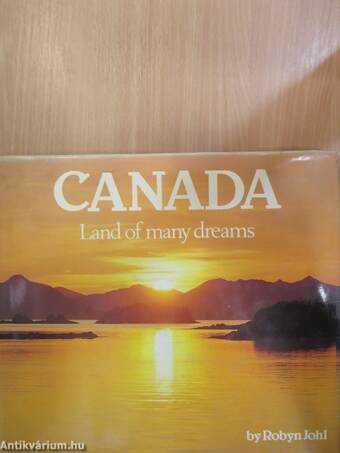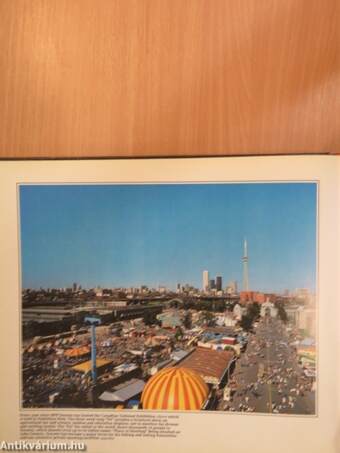1.060.478
kiadvánnyal nyújtjuk Magyarország legnagyobb antikvár könyv-kínálatát

VISSZA
A TETEJÉRE
JAVASLATOKÉszre-
vételek
Canada
Land of many dreams
| Kiadó: | Colour Library Books Ltd. |
|---|---|
| Kiadás helye: | Sujrrey |
| Kiadás éve: | |
| Kötés típusa: | Varrott keménykötés |
| Oldalszám: | 196 oldal |
| Sorozatcím: | |
| Kötetszám: | |
| Nyelv: | Angol |
| Méret: | 28 cm x 32 cm |
| ISBN: | 0-86283-084-2 |
| Megjegyzés: | Színes fotókkal. |
naponta értesítjük a beérkező friss
kiadványokról
naponta értesítjük a beérkező friss
kiadványokról
Fülszöveg
Canada is vast, far larger than any other
member of the Commonwealth, and the
second largest country in the world. It
stretches from the Atlantic Ocean to the
Pacific Ocean and from the United States
border to the North Pole. Halifax on the east
coast is farther from Vancouver on the west
coast than it is from London. Such
staggering vastness is a dominating feature
because it creates a diversity of climate and
vegetation that has greatly influenced the
human environment and also because much
of this huge area is still undeveloped and
indeed, at present, is still undevelopable.
This country has spectacular scenery of
great contrast and grandeur; there are huge
mountain ranges, dense forests, wide
expanses of prairie, tremendous rivers and
cataracts and lakes twice the size of
England. One thirteenth of Canada is fresh
water. There are four of the Great Lakes,
Superior, Huron, Erie and Ontario, partly in
Canadian territory and many other lakes
completely in... Tovább
Fülszöveg
Canada is vast, far larger than any other
member of the Commonwealth, and the
second largest country in the world. It
stretches from the Atlantic Ocean to the
Pacific Ocean and from the United States
border to the North Pole. Halifax on the east
coast is farther from Vancouver on the west
coast than it is from London. Such
staggering vastness is a dominating feature
because it creates a diversity of climate and
vegetation that has greatly influenced the
human environment and also because much
of this huge area is still undeveloped and
indeed, at present, is still undevelopable.
This country has spectacular scenery of
great contrast and grandeur; there are huge
mountain ranges, dense forests, wide
expanses of prairie, tremendous rivers and
cataracts and lakes twice the size of
England. One thirteenth of Canada is fresh
water. There are four of the Great Lakes,
Superior, Huron, Erie and Ontario, partly in
Canadian territory and many other lakes
completely in Canada. The Mackenzie river
flows 2,500 miles to the Arctic while the
most important waterway in the world, the
St Lawrence, drains the Great Lakes and is
the main route from the Atlantic to the
interior. The far northern coast is a network
of peninsulas and inlets, with Hudson Bay
thrusting south like an enormous inland sea.
The coastline is rugged, both east and west,
and is one of the longest in the world, and
the seas contain an abundance of fish.
Behind the Pacific Coast rise the great
mountains of the Rockies. This area of great
natural beauty contains soaring pinnacles of
rock and frozen glaciers. From the foot of the
mountains the prairies extend eastwards to
the horizon, forming the breadbasket of
Canada, where the vast majority of crops are
grown. Finally there are the hills and coasts
of eastern Canada whose inlets and valleys
were populated first by Europeans. All areas
have a unique natural beauty which is at
once captivating and exhilarating.
But the towns and cities should not be
ignored; they too are an important feature in
the charm of this great country. From
Quebec, with its atmosphere of old France,
and Calgary, with the flavor of the old West
perpetuated in the Stampede, to Vancouver,
Canada's great maritime city, each town has
an exciting atmosphere, found nowhere else,
which draws the visitor back for more. Vissza
Témakörök
- Idegennyelv > Idegennyelvű könyvek > Angol > Művészetek > Fotóművészet
- Idegennyelv > Idegennyelvű könyvek > Angol > Helytörténet
- Helytörténet > Külföldi > Egyéb
- Helytörténet > Honismeret > Országos
- Művészetek > Fotóművészet > Albumok > Külföldi
- Művészetek > Fotóművészet > Albumok > Tematikus
- Művészetek > Fotóművészet > Idegen nyelv > Angol
- Művészetek > Fotóművészet > Témái > Egyéb


















